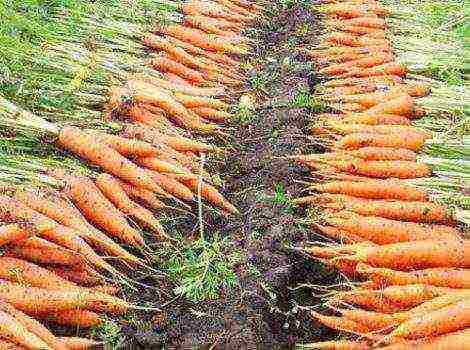Content [show]
Edible honeysuckle is not only a useful plant that can give a rich harvest of delicious berries, but also a bright decoration of the spring garden. Let's see which varieties of honeysuckle should be preferred.
Based on the opinion of experienced gardeners, we have selected the top ten varieties. Although, in terms of decorative qualities, these shrubs can sometimes be inferior to other types and varieties of honeysuckle, but first of all they are famous for their good yield, winter hardiness and unpretentiousness.
In the list, the varieties are located not by popularity (they are all held in high esteem by gardeners), but alphabetically.
1. Altair
This early ripening variety has already managed to fall in love with many gardeners due to its resistance to cold, common diseases and pests. Delicious and sweet berries (blue-blue with a waxy coating) ripen on a bush with a dense and squat crown in mid-June and do not crumble for a long time. Therefore, Altair is great for people who come to the country no more than once a month. After all, even fully ripe berries remain on the plant until you pick them.
| Bush height (m) |
Ripening period berries |
Fruit weight (g) |
Yield (kg per bush) |
Pollinating varieties |
| Up to 1.4 | June 12-16 | 0,9-1 | 1,7-2 |
Blue spindle Malvina, Morena |
2. Bakchar giant
This large-fruited variety of medium ripening is suitable for those who have enough free space on the site. After all, the powerful bushes of the Bakchar giant reach a height of almost 2 m, and a width of 1.3 m. The crown is oval, spreading, loose. Thanks to the sparse crown, it is convenient to pick fruits from the bush.
Leaves are gray-green, matte. Berries are large (up to 5 cm long), elongated-oval, slightly asymmetrical, dark blue with a waxy bloom. Fruits can be eaten fresh, frozen, and can also be used for making wines, juices, jellies, compotes, and preserves from them.
The plant is winter-hardy, resistant to diseases and pests.
| Bush height (m) |
Ripening period berries |
Fruit weight (g) |
Yield (kg per bush) |
Pollinating varieties |
| 1,7-1,9 | end of June | 1,8-2,5 | 2-3 |
Amphora, Pride of Bakchar, Azure, Nymph, In memory of Gijuk |
3. Blue spindle
This early maturing honeysuckle is distinguished by its high yield, good resistance to frost and drought, as well as to diseases and pests.
The crown of the bush is rather rare, the shoots are thin, straight, greenish in color. Leaves are oval, elongated, dark green. The berries are large (about 2.7 cm long), shaped like an elongated spindle. The skin is blue with a waxy bloom. The flesh is sweet and sour, but can taste bitter during drought. Therefore, when growing this honeysuckle, you must observe the watering regime.
The disadvantage of this variety is that ripe berries quickly crumble.
| Bush height (m) |
Ripening period berries |
Fruit weight (g) |
Yield (kg per bush) |
Pollinating varieties |
| Up to 1 m | June 12-23 | 1-1,5 | 1,5-2,5 |
Cinderella, Kamchadalka, Azure, Bluebird, Tomichka, In Memory of Gidzyuk |
4. Long-fruited
This is one of the first zoned Ural varieties. Long-fruited honeysuckle is characterized by high winter hardiness and early ripening of fruits in the form of an elongated flat cylinder. Their length is up to 2.7 cm. The bush is spreading, with a rounded crown. Shoots are thin, long. Leaves are lanceolate, elongated, dark green.
The skin of the fruit is thin, violet-blue, with a whitish waxy coating. The pulp is sweet and sour, tender, without bitterness. Sprinkling rate of ripe berries is average.
| Bush height (m) |
Ripening period berries |
Fruit weight (g) |
Yield (kg per bush) |
Pollinating varieties |
| Up to 1 m | June 10-20 | 0,9-2 | 1,4-3 |
Zest, Smolinskaya, Sineglazka, Morena, Chernichka. But the best pollinator variety is Chelyabinka |
5. Cinderella
On compact low bushes with a dense crown, thin light green shoots and leaves of the same color, tasty berries ripen in the form of an elongated cylinder or spindle. The skin is thin, dark blue (almost black) with a blue bloom. The pulp is soft, sweet and sour, with a light strawberry aroma, very tasty.
Due to the low growth of the bush, picking berries is difficult, and they also quickly crumble. However, most of the fruits are located on the outside of the crown, therefore, when manually harvesting, it is possible to save the crop.
The variety is distinguished by very good winter hardiness, flowers are immune to recurrent spring frosts. In addition, the plant is resistant to disease.
| Bush height (m) |
Ripening period berries |
Fruit weight (g) |
Yield (kg per bush) |
Pollinating varieties |
| 0,6-0,7 | June 15-22 | 0,6-1,4 | 1-3 |
Azure, Gerda, Amphora, Kamchadalka, Leningrad giant, In memory of Gidzyuk, Parabelskaya, Tomichka |
6. Leningrad giant
An adult shrub of this vigorous honeysuckle can reach a height of just over 2 m. It is erect, slightly spreading, with a compact rounded-oval crown. Berries are large (about 3 cm long), as a rule, elongated-cylindrical in shape. They ripen unevenly throughout the month. The berries are arranged in bulky bunches, so they are easy to pick.
The skin is dense, dark blue, with a thin layer of gray waxy bloom. The pulp is dense, fibrous, delicate in taste, sweetish-sour, does not taste bitter.
The variety is resistant to diseases and pests, the plant is not damaged by frost even in severe winters, the flowers can withstand spring frosts down to –7 ° С.
| Bush height (m) |
Ripening period berries |
Fruit weight (g) |
Yield (kg per bush) |
Pollinating varieties |
| 1-2 | June 20 - July 30 | 1-4 | 1-3,3 |
Gzhelka, Blue spindle, Malvina, Morena, In memory of Kuminov, Bluebird, Start |
7. Morena
This early-maturing honeysuckle has a rather wide (up to 1.7 m) and squat crown of an oval shape, lanceolate leaves of a light green color and large fruits (up to 3 cm long) in the form of an elongated jug. They have a thin, almost transparent, blue-blue skin with a pronounced waxy coating. The pulp of the berries is sweet and sour, tender, with a light aroma, without bitterness. Ripe fruits do not fall off the bush for a long time.
The winter hardiness of the variety is above average. The plant is rarely damaged by pests and practically does not get sick.
| Bush height (m) |
Ripening period berries |
Fruit weight (g) |
Yield (kg per bush) |
Pollinating varieties |
| Up to 1.7 | June 15-30 | 1-3 | 1,2-2 |
Viola, Amphora, Blue spindle Kamchadalka, Malvina, In memory of Kuminov, Bluebird, Start |
8. Nymph
The shrub of this variety is medium-sized, with a rounded and slightly spreading crown, prone to thickening. Shoots are long, straight, brownish-green. Leaves are oblong-oval, dark green. The berries are rather large (up to 3 cm long), elongated, resemble a spindle in shape, sometimes they are curved and have bumps on the surface.
The skin is bluish-blue, covered with a waxy bloom of medium intensity. The pulp is fibrous, sweetish-sour, slightly tart, with a spicy aroma and light bitterness. On young plants, ripe berries do not crumble for a long time, and on old ones, ripe fruits quickly end up on the ground.
The variety is very winter hardy, suitable for growing in extreme conditions. The plant is rarely sick.
| Bush height (m) |
Ripening period berries |
Fruit weight (g) |
Yield (kg per bush) |
Pollinating varieties |
| Up to 1.7 | June 13-30 | 1-3 | 1,3-2 |
Amphora, Chosen One, Azure, Pavlovskaya, In memory of Gijuk |
9. Bluebird
This variety is obtained on the basis of Kamchatka honeysuckle. Bushes - vigorous, with a spreading oval crown. Shoots are thin, straight. Leaves are oval, with a pointed tip. Berries are medium (up to 2 cm long), in the form of a slightly elongated ellipse. The skin is bluish-black, with a strong waxy bloom. The pulp is tender, sour-sweet, slightly tart. The fruit tastes like blueberries.
Honeysuckle Blue bird is unpretentious in care, almost does not get sick, does not freeze in winter and is not afraid of harmful insects.
| Bush height (m) |
Ripening period berries |
Fruit weight (g) |
Yield (kg per bush) |
Pollinating varieties |
| 1,3-1,8 | June 14-22 | 0,8-1,2 | 1-2 |
Blue spindle, Cinderella Kamchadalka, Malvina, Morena, In Memory of Kuminov, Titmouse, Start |
10. Tomichka
This plant has a compact, semi-spreading crown, the ends of the shoots falling to the ground. Leaves are light green, slightly pubescent. The berries are shaped like a jug or a wide drop with a depressed top. They have an uneven surface, the skin is blue-violet (almost black) with a waxy coating. The pulp is sweet and sour, without bitterness. The berries are not crumpled during transportation.
In rare cases, the plant can damage aphids.
| Bush height (m) |
Ripening period berries |
Fruit weight (g) |
Yield (kg per bush) |
Pollinating varieties |
| 1,5-1,6 | June 10-20 | 1-2 | 2,5-3,2 |
Blue Spindle, Blue Bird, Pavlovskaya, Bakcharskaya, Vasyugan, Daughter of the Giant, Bakchar giant |
Do you grow edible honeysuckle on the site? If you have not yet decided to "settle" this useful shrub in your garden, read our article 5 reasons to grow honeysuckle in the garden. We hope she will dispel all your doubts!
Honeysuckle relatively recently began to be grown as a berry crop. But breeders have already managed to develop many varieties of this plant, which differ significantly from each other both in taste characteristics and in the degree of resistance to adverse conditions.
Edible Honeysuckle
To date, more than 100 types of honeysuckle are known. The fruits of almost all of them are inedible, and some are poisonous. So, eating the berries of the common honeysuckle (Lonicera xylosteum), which is widespread in the forests of our country, can be fatal.

The fruits of the common honeysuckle are very poisonous.
In Russia and the CIS countries, only one species of this plant with edible berries is cultivated - blue honeysuckle, or blue (Lonícera caeruléa). It is a deciduous shrub 1 to 2 m high with bluish-black oblong berries that taste like blueberries. In the wild, this species of honeysuckle is most commonly found in East Asia.
Video: honeysuckle - a guest from the Far East
Blue honeysuckle has many subspecies. Among them:
- Altai honeysuckle. Shrub no more than 1 m high. Black-blue fruits with a pronounced bitterness ripen throughout the summer. This honeysuckle grows in the forests of Altai, Siberia and the Urals, but can also be found on open mountain slopes;
- Kamchatka honeysuckle. Strongly branched shrub 1.5–2 m high. Begins to bear fruit in the second decade of June. Dark blue berries have a sweet-sour, slightly tart taste;
- Pallas honeysuckle. Shrub up to 1 m high. Its bluish-black fruits ripen from late June to early September. Most often they have a bitter taste, but there are specimens with rather sweet berries. Pallas honeysuckle usually grows in moist coniferous forests of North-Eastern Europe and Siberia;
- honeysuckle Turchaninov. Shrub about 1 m high with a dense spherical crown. Berries come in both oblong and round shapes. Their taste ranges from sweet to bitter sour. In the wild, Turchaninov's honeysuckle is found only on Sakhalin;
- honeysuckle is edible. A low-growing shrub, the maximum height of which does not exceed 1 m. The dark blue berries with a bluish bloom ripen in late June - early July. They are appreciated for their sweet and sour taste and pronounced aroma. Edible honeysuckle is often found in the coniferous and deciduous forests of Eastern Siberia and the Far East.
Most subspecies of blue honeysuckle have similar characteristics. Often only professional biologists can distinguish between them.
Description and characteristics of different varieties of honeysuckle
When creating new varieties, breeders use different subspecies of honeysuckle. This allows you to obtain plants that meet the various requirements of gardeners. The following characteristics are especially important:
- resistance to adverse natural conditions;
- the presence of immunity to common diseases and pests;
- fruiting period;
- yield;
- the degree of crumbling;
- the size and flavor of the berries.
Sweet varieties
In the wild, the fruits of blue honeysuckle often taste bitter. Breeders have done a great job in order to rid the fruits of cultivated plants from this disadvantage. As a result, many varieties have been developed that have a rather sweet taste.
Siberian
Sibiryachka was created in 1972 by employees of the Bakcharsky point of northern gardening (Tomsk region). Its fruits 1.9–2.4 cm long and weighing up to 1.4 g contain 8.5% sugars and 1.2% acids. Sibiryachka berries are very juicy and aromatic. They are eaten both fresh and processed.
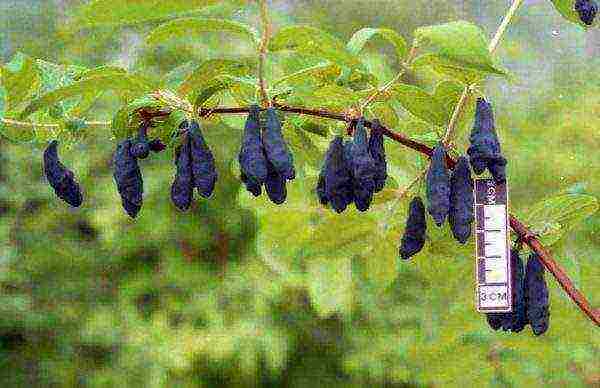
The Sibiryachka variety is valued for its sweet and aromatic berries.
The maximum plant height is 1.6 m. Fruiting begins in the 2-3rd year of the plant's life. Ripening of berries is amicable, usually in mid-June. In the first year of fruiting, 0.5 kg of berries can be harvested from the plant. The bush reaches its maximum yield (about 4 kg) by the age of 14-15. Active fruiting continues for 25-30 years.
Sibiryachka is a very winter-hardy variety that can withstand air temperatures down to -50 ° C. In addition, the bush easily tolerates drought and is almost not exposed to pests and diseases.
Among the disadvantages of the variety are:
- rather thin skin of the fruit, excluding the possibility of long-term transportation;
- shedding of berries not removed in time, especially strong in conditions of lack of moisture;
- severely curved branches that make harvesting difficult.
Nymph
The Nymph variety was obtained at the Pavlovsk station of the N.I. Vavilov (St. Petersburg). Its main advantage is sweet and aromatic berries with an almost complete absence of bitter aftertaste. The bluish-blue fruits of the Nymph, the average weight of which is 0.8 g, are securely attached to the branches, so that they do not crumble for a long time.
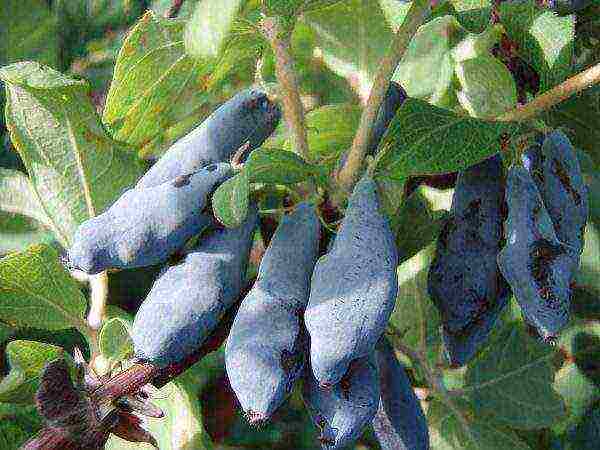
Nymph berries have an elongated fusiform shape and a slightly lumpy surface.
Nymph is a vigorous variety. An adult plant can reach a height of 2.5 m. In the middle lane, the fruits ripen in the last decade of June. The yield is usually about 2 kg per bush. Under favorable conditions and good care, it can increase to 3–3.5 kg per plant.
The nymph easily tolerates frosty winters: the shoots remain viable at -50 ° C, and the roots at -40 ° C. Flowers and ovaries can withstand short-term temperature drops down to -8 ° C. This variety is rarely affected by aphids and does not suffer from powdery mildew or tuberculariosis.
Many gardeners note the tendency of the Nymph to thicken the crown. This can be easily avoided by pruning the branches in a timely manner.
Silginka
Silginka was bred by the employees of the Bakchar point of northern gardening. The bush rarely grows above 1.4 m. The berries have a sweet, slightly sour taste and delicate aroma. The fruits are dark blue, elongated, with a pointed tip. Their average weight is 1.2–1.4 g. They reach technical ripeness by the end of June. Up to 3 kg of berries can be harvested from one plant. The main disadvantage is strong crumbling. At the same time, the easy separation of the berries from the stalk allows you to quickly and effortlessly collect the entire crop.
Silginka is very resistant to the vagaries of the weather. It easily tolerates winter frosts, summer heat and prolonged absence of rain. Plants of this variety rarely suffer from diseases and pests.
Practically the tastiest, sweetest and largest among the varieties in the garden. If you lay the material under the bush in advance, it can be easily collected by shaking, the berries easily crumble when ripe. Harvest in the 4th year from planting 1.5 kg. I consider it a good result for myself. A worthy variety for every garden!
Video: Silgink's honeysuckle
Cinderella
A selection variety of the Siberian Research Institute of Horticulture named after M.A. Lisavenko. The berries have a harmonious sweet-sour taste and aroma reminiscent of strawberry.

The Cinderella variety was bred in 1974
The height of the bush is no more than 70 cm. The weight of the berries varies from 0.7 to 1.4 g. They usually ripen in the second decade of June. In some cases, fruiting takes several weeks. Cinderella is distinguished by its early maturity: the first berries can be picked already in the 2nd year of the plant's life. 7–8 years after planting, the bush yields from 2 to 5 kg of fruit.
Honeysuckle of this variety is resistant to low temperatures. For all the years of observations in Siberia, not a single case of damage to bushes from frost or sudden changes in weather was noted. Cinderella is immune to most common diseases.
Large-fruited varieties
Today there are varieties whose berry weight exceeds 2 g. Many of them, in addition to outstanding sizes, have excellent taste and resistance to unfavorable conditions.
Bakchar giant
One of the largest-fruited varieties of honeysuckle. The average weight of its fruits is 1.8 g, and the maximum weight is 2.5 g. The taste of the berries is sweet and sour. Their flesh is very juicy and tender.
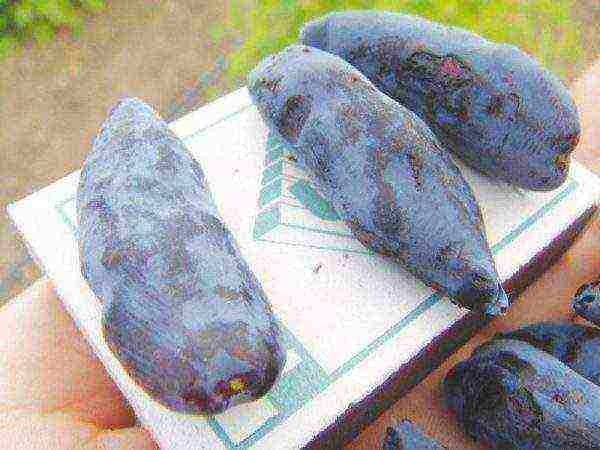
The length of the Bakchar giant fruit is 4–5 cm
The bush of the Bakchar giant is quite powerful. Its height can reach 2 m, and its width - 1.5 m. The crown is very thinned, which greatly facilitates the collection of berries. This variety tolerates severe winter frosts without much loss and is rarely affected by pests.
The fruits ripen in late June - early July.The average yield is about 2.5 kg of berries per plant, the maximum is 4.5 kg. Ripe berries fall off the bush quite easily.
Bakchar Giant - I love! I have not seen abundant yield yet. The berries are huge, the skin is thin, not perceptible, the taste is sour, it makes no sense to overexpose on the bush. It does not become sweeter, and when overripe, the berries become very tender, choking in the hands.
Leningrad giant
The Leningrad giant is prized by gardeners for its large and sweet fruits without characteristic bitterness. The weight of the berries of this variety can reach 4 g. The advantages also include:
- high yield (average - 3 kg per plant, maximum - 5 kg);
- dense skin of the fruit, allowing you to transport berries without much loss;
- slight crumbling;
- resistance to severe frosts, as well as to diseases and pests.
The disadvantages of this variety include uneven ripening of fruits, which often stretches from mid-June to late July.

The fruits of the Leningrad giant grow in clusters, which greatly simplifies their collection.
Early varieties
Honeysuckle is the first berry to ripen in our plots. Many gardeners strive to speed up this process and choose the earliest varieties of crops for planting, the fruits of which ripen already in late May or early June.
Blue spindle
An early ripe variety, bred by employees of the M.A. Lisavenko in 1980. The berries of the Blue Spindle ripen in the first half of June in the conditions of central Russia and Siberia, and in the south in May. Their average weight is about 1 g.
The fruits have a pleasant sweet and sour taste. But with a lack of moisture, noticeable notes of bitterness appear in them. Because of this, Blue Spindle berries are often consumed in processed form. The blue spindle has a high fertility rate. The first berries appear the next year after planting. The average yield is about 2 kg per plant. The main disadvantage of this variety is its rather strong crumbling, due to which up to 15% of ripe fruits are lost.
I didn't really like the Blue Spindle variety. The berries are interesting, spindle-shaped, but not only are they sour, they also taste bitter.
Video: Comparison of Blue Spindle Honeysuckle with other varieties
Swan
In central Russia, Swan berries ripen in early June. They are characterized by a pleasant sweet and sour taste. The average weight of elongated-cylindrical fruits is 1.2–1.5 g.
Mature bushes of this variety grow up to 2 m. The yield of one plant under favorable conditions reaches 2.5 kg. Among the advantages of the Swan, experts note the dense skin of the fruit, thanks to which they are perfectly kept fresh for about 5 days. In addition, the plants perfectly tolerate frost and sudden temperature fluctuations in winter.
Blue bird
Fruiting of the Blue Bird variety usually occurs in mid-June. Small berries (0.7-0.9 g) have a sweet taste and aroma similar to blueberry.
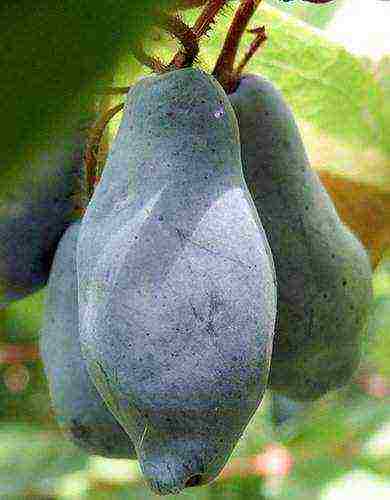
Bluebird fruits ripen in mid-June
Bluebird bushes are vigorous, with a dense spherical crown. Mature plants grow up to 1.8 m in height. Ripe berries stick tightly to the branches and practically do not crumble.
The main disadvantage of this variety is its rather low yield. No more than 2 kg of berries can be harvested from one plant.
Non-crumbling varieties
The berries of most honeysuckle varieties crumble easily, which is why gardeners who do not harvest ripe fruits on time can lose most of the harvest. Breeders are constantly working to eliminate this deficiency.
Amphora
Amphora berries weighing about 1.2 g are firmly attached to the branches, which can make harvesting difficult. Under favorable conditions, about 2 kg of fruits are harvested from one bush.
The main advantages of this variety include:
- harmonious sweet and sour taste with a slight bitterness;
- thick and dense skin of the fruit, which guarantees good transportation;
- friendly ripening of fruits;
- resistance to low temperatures.
Amphora is rarely affected by disease. But in some cases, young shoots of the plant may suffer from aphids or honeysuckle mites. To avoid this, it is necessary to prevent thickening of the crown and monitor the general condition of the bush.
Moraine
Morena (or the Little Mermaid) is an early ripening variety. Its large water lily fruits ripen in mid-June. The average yield is about 1.5 kg per adult plant. In especially favorable years, it can reach 2.5 kg. Ripe fruits do not wither for a long time and do not crumble.
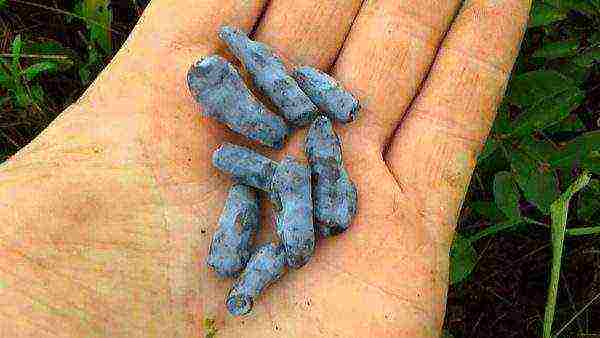
Morena fruits grow up to 3–3.5 cm in length and weigh about 1.5 g
Morena berries have a sweet-sour dessert taste without bitterness and a pleasant weak aroma. They are often used in the preparation of desserts and preparations for the winter. Morena is included in the State Register of Varieties as a crop recommended for cultivation in all regions of Russia. It perfectly tolerates severe frosts and drought, and also has a high resistance to major diseases and pests.
Morena seemed to me of my 10 varieties the most beautiful, large and dessert and without bitterness, in such a dry spring it showed an excellent result (there was no rain at all in May), it wintered well and was covered with large dessert berries, the branches did not dry out, unlike some other varieties, the berries are very large, but light.
Malvina
Malvina belongs to the medium early varieties of honeysuckle. In the central region of Russia, its fruits usually ripen in mid-June. Ripe berries stick well to the stalk and do not crumble.
The height of the Malvina bush exceeds 1.5 m. The berries are elongated pear-shaped with a dense skin. Their pulp has a sweet and sour dessert taste and delicate aroma. The average fruit weight is slightly more than 1 g. The yield of this variety is quite high. With good care, it is possible to collect about 3 kg of berries from one bush.
Varieties of modern selection
Breeders do not stop working on the creation of new varieties of honeysuckle. At the same time, they pay much attention to the consolidation of such qualities as high yield, large-fruited, lack of bitterness and resistance to adverse natural conditions.
Daughter of a giant
The giant's daughter was bred in 2009 by the specialists of the Bakchark stronghold of northern gardening. Today this variety is one of the largest. The length of the berries can reach 6 cm, and the weight is 2.5–3 g. Fruit ripening is rather extended in time and covers the period from late June to mid-July.

The Giant's Daughter berries are much larger than most honeysuckle varieties.
Also among the virtues of the Giant's Daughter include:
- high yield (from 3.5 to 5 kg per plant);
- sweet and sour pleasant taste;
- fruits do not crumble;
- dry separation of berries;
- excellent transportability of fruits;
- resistance to low temperatures and lack of moisture, diseases, pests.
The daughter of a giant is a large, beautiful berry, ripens later than other varieties, the skin is denser than that of the Bakchar giant, the taste is more pleasant.
Sweetheart
The newest selection of the Kamchatka Research Institute of Agriculture. Sweetheart fully lives up to its name. Its fruits contain 13.3% sugar and 1.8% acid. The characteristic features of this variety are:
- purple with a strong waxy bloom, the fruit color is almost regular cylindrical in shape;
- small size of berries (maximum weight about 1.5 g);
- sweet and sour taste of pulp with a pronounced aroma;
- high productivity;
- early maturity (in the conditions of the Moscow region, the fruits ripen in mid-June);
- resistance to low temperatures and diseases.
The subtleties of choosing a variety for different regions
When choosing a variety of honeysuckle, experienced gardeners pay special attention to its adaptability to the climatic conditions of a particular region. Plants that bear fruit well in the North may not withstand the hot weather of more southern regions, and vice versa.
Recommended varieties for growing in Siberia
Siberia is the optimal region for growing honeysuckle. Almost all cultivated forms of this plant are perfectly adapted to cold winters and short wet summers. The best results when grown in Siberia are shown by the following varieties:
- Bakchar giant;
- Siberian;
- Cinderella;
- Amphora;
- Moraine.
Honeysuckle for the Moscow region and the middle lane
In the Moscow region and in other regions of the middle lane, honeysuckle often suffers from repeated autumn flowering, which significantly weakens the plant and prevents successful wintering and abundant fruiting in the next season. The main reason for this is the warm weather in September-October. Moscow varieties are particularly resistant to repeated flowering:
- Kingfisher;
- Gzhel early;
- Moscow 23;
- Ramenskaya;
- Roxanne;
- Amphora.
The champion in yield among them is the Moskovskaya 23 variety, from one bush of which up to 4 kg of sweet, slightly tart berries can be harvested. They usually ripen in the first half of June. The fruits must be picked on time, otherwise they will begin to crumble.
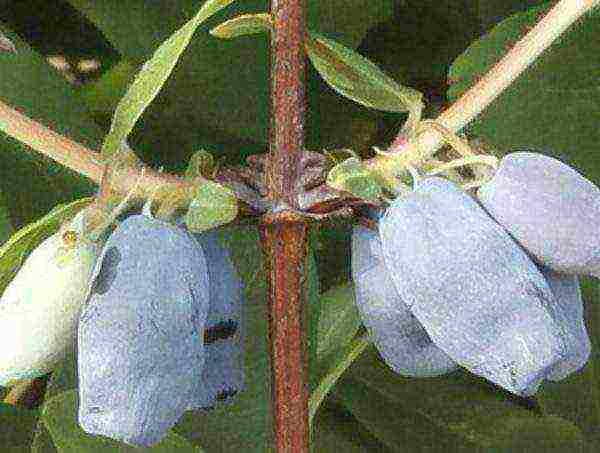
Berries of the Moscow 23 variety weigh about 1 g
Gardeners who prefer sweet berries choose Kingfisher. There is practically no bitterness in the taste of the fruits of this variety. Other pluses include:
- the yield is above average;
- resistance to severe frosts and pests;
- berries do not crumble.
Varieties for the Leningrad region and the North-West region
When choosing a variety for planting in the gardens of the Leningrad region and the North-West region, it is necessary to take into account its resistance to freezing after short-term thaws. This quality is possessed by:
- Leningrad giant;
- Swan;
- Amphora;
- Moraine;
- Nymph.
They perfectly tolerate the climatic conditions of this region and varieties of Moscow selection.
Varieties cultivated in Belarus
In terms of its climatic conditions, Belarus is very similar to the North-West region of Russia, therefore, the varieties of honeysuckle cultivated in the Leningrad region feel great here. In addition, the breeders of this country do not stop working on the creation of their own varieties. In 2007, they bred the Zinri variety, which is distinguished by an early harvesting date (June 3–9).
Other features of the Zinri variety:
- excellent sweet taste with a refreshing aroma;
- fairly high yield (up to 3 kg per plant);
- resistance to low temperatures and fungal diseases;
- low degree of fruit crumbling.

Zinri berries are barrel-shaped
Honeysuckle for Ukraine and southern regions of Russia
Honeysuckle, which grows in Ukraine and southern Russia, suffers greatly from hot and dry summers. It is almost impossible to get a good harvest under these conditions. Also, with a lack of water, the fruits of many varieties acquire strong bitterness. Silginka is a pleasant exception to this rule. She quite easily tolerates extreme heat and prolonged absence of rain.
Experts of the State Commission of Ukraine for Testing and Protection of Plant Varieties recommend two varieties of honeysuckle for planting in the gardens of Poltava, Sumy and Kharkov regions:
- Bogdan. A high-yielding variety that is not prone to shedding. The fruits ripen in the last decade of May and have a sweet dessert taste;
- Violet. The average yield is just under 2 kg per plant. The pulp of the fruit is sweet and sour with a delicate aroma. On the territory of Ukraine, the berries ripen in early June. A significant disadvantage of this variety is the tendency to shedding, due to which you can lose up to 40% of the crop.
To minimize the adverse effects of the hot climate, experts recommend regularly watering the honeysuckle bushes. An excellent result is also obtained by planting this culture near the shores of natural and artificial reservoirs.
Honeysuckle is growing in the south. Suffers from thaws in winter and hot weather in summer. Therefore, the harvest even on 10-year-old bushes is small.
What varieties of honeysuckle should be planted together
All varieties of blue honeysuckle are self-fertile.For pollination of flowers and the appearance of berries, the presence of representatives of another variety in the reach zone is necessary. The more there are, the richer the harvest. When choosing varieties for a garden, it is imperative to take into account the timing of flowering plants. If they do not match, pollination will be impossible and the fruits will not be tied.
According to most breeders, the taste of the berries and the size of the harvest depend on the choice of the pollinator.
Table: Best Pollinators for Popular Varieties
An important condition for obtaining a good harvest of honeysuckle is a competent choice of the variety. In this case, it is necessary to take into account not only your own preferences, but also the climatic conditions of the region in which cultivation is planned. Subject to this rule, honeysuckle will delight the gardener for a long time with tasty and healthy berries.
Rate the article:
(13 votes, average: 3.9 out of 5)
Honeysuckle is a shrub that appeared in our gardens not so long ago, only 10-15 years ago. The varieties of honeysuckle, bred by modern breeders, are so diverse that they allow you to grow this garden crop in different climatic zones. It should be noted that honeysuckle was IV Michurin's favorite berry, he is the creator of many of its main varieties.
General description of the plant
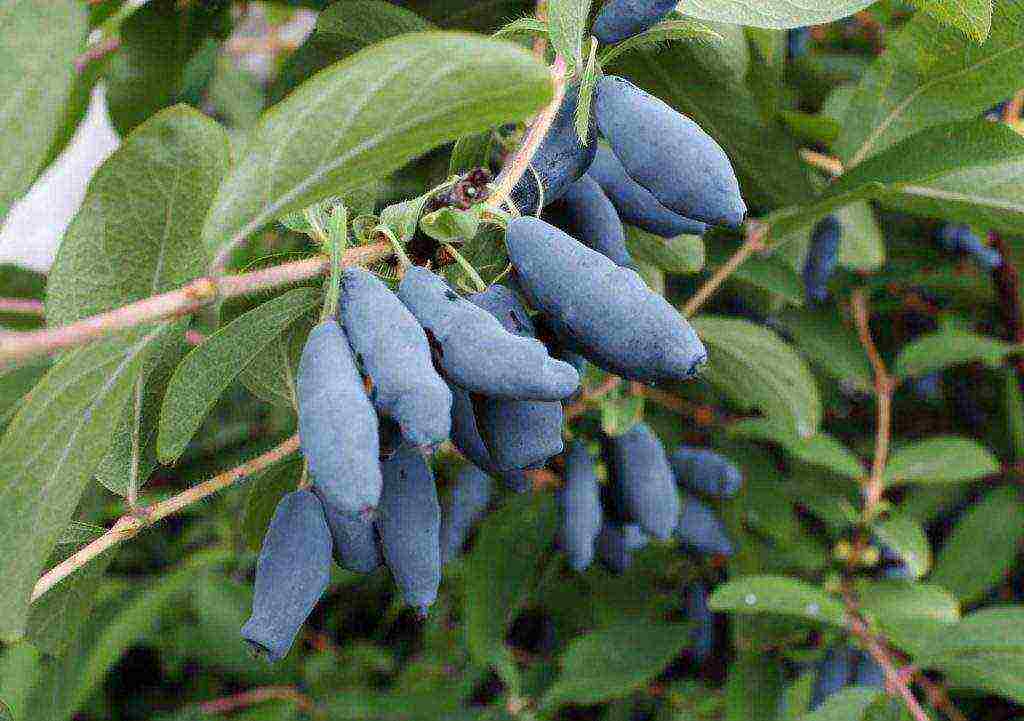
Honeysuckle belongs to perennial shrubs, the height of an adult bush ranges from 0.5 m to 3 m, depending on the variety. The leaves are oblong, smooth, green on the outside, paler on the inside. It usually blooms in mid-May, even before the leaves are completely dissolved, the flowers are white-pink, collected in a brush. The wonderful scent of the flowers attracts bees, which contributes to good pollination.
The plant is unpretentious and frost-resistant. Begins to bear fruit at the age of 3 years and gives a very good harvest, from 2 to 4 kg of berries from a bush. Fragrant bushes with bright berries can decorate any garden.
The fruits ripen in early summer, have an oblong shape, size from 1 to 5 cm, are colored blue with a gray coating. The berries have a rather exquisite taste, sweetish with sourness. Honeysuckle berries contain a lot of vitamins and antioxidants, their use contributes to the prevention of heart attacks and strokes, cleansing the gallbladder, they are useful for poisoning, colds and inflammations.
The berries are frozen, dried, made from them jam, jam, preserves, compote, juice, and even get an unusually tasty wine. The calorie content of berries is low, only 30 kcal per 100 g. The sugar content is not more than 9%.
Honeysuckle bushes are planted either in late summer or early spring. The plant needs pollinators, and therefore at least two varieties of honeysuckle are planted next to each other. Planting sites are sunny with well-fertilized soil. The bushes are planted at a distance of at least 1.5 m from each other. Caring for honeysuckle is simple, you only need to cut off the dried branches.
The only drawback of honeysuckle is that the skin of the berries is too thin and delicate and their ability to simultaneously crumble from the bush. So that the berries are not damaged when falling, gauze or other soft mesh fabric is pulled under the bushes. But this disadvantage will soon be overcome. Modern breeders are working on developing honeysuckle varieties with stronger skins.
The best varieties of honeysuckle for central Russia
Altair

An early maturing variety of honeysuckle, resistant to frost, diseases and pests. The height of the bush is up to 1.4 m, the berries ripen in mid-June, the weight of the berry is about 1 g. Up to 2 kg of crop can be harvested from a bush.
Delicious and sweet berries of a bright blue color with a waxy coating, do not fall off the bush for a relatively long time, are suitable for planting in summer cottages. The pollinators of this variety are Malvina, Blue Spindle, Morena.
Bakchar Giant
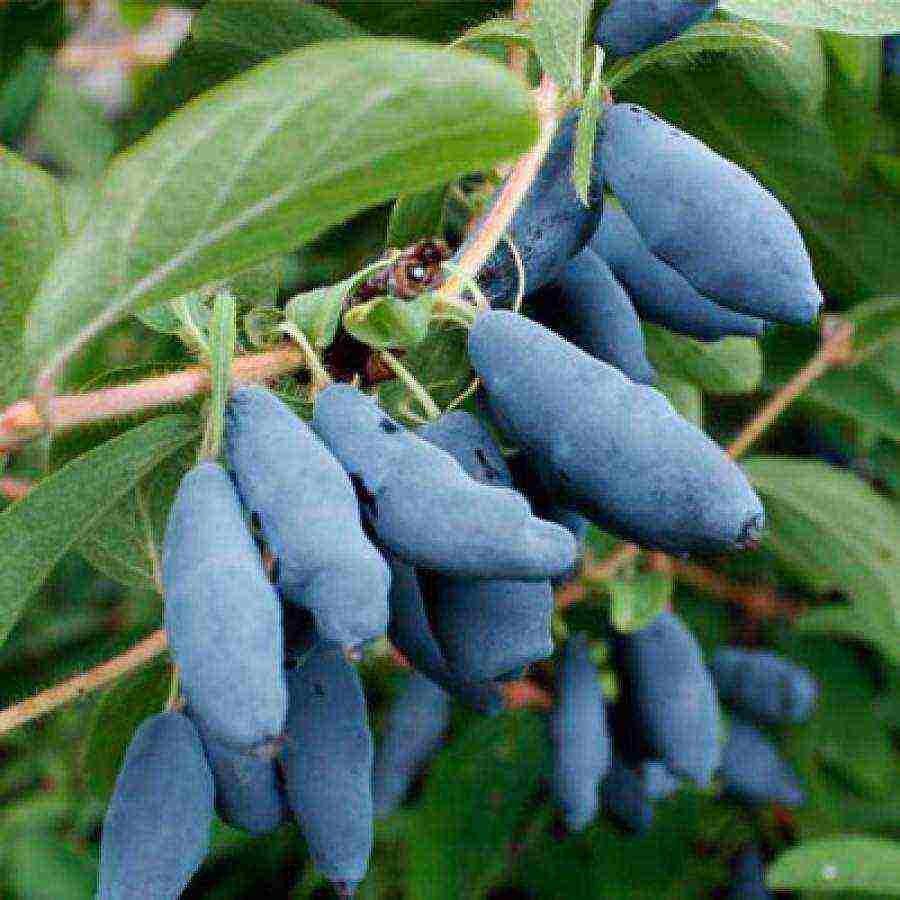
A large-fruited variety with an average ripening period. Bushes 2 m high and 1.3 m wide.Frost-resistant, little susceptible to diseases and pests.
Fruits are bright blue with a bluish bloom, up to 5 cm long, weighing 1.8-2.5 grams. ripen at the end of June. 2-3 kg of harvest is harvested from the bush. Berries can be harvested for the winter by freezing, making wine, jam, jelly, compote and juice from them. The best pollinators of the variety are Amphora, Lazurnaya, In Memory of Gidzyuk, Nymph, Pride of Bakchar.
Blue spindle

Early maturing honeysuckle, resistant to frost, disease and pests. The height of the bush reaches 1 meter. The berries are large, up to 2.7 cm long, blue with a bluish bloom, berry weight up to 1.5 grams, yield up to 2.5 kg per bush.
The pulp of the berry is sweet and sour, but if the watering was insufficient, then a slight bitterness is felt, so it is imperative to observe the watering regime. The disadvantages of this variety include the thin skin of the fruit and the ability to quickly shed from the bush. Pollinator varieties - Cinderella, Blue Bird, Tomichka, Kamchadalka, Azure, in Memory of Gidzyuk.
Long-fruited
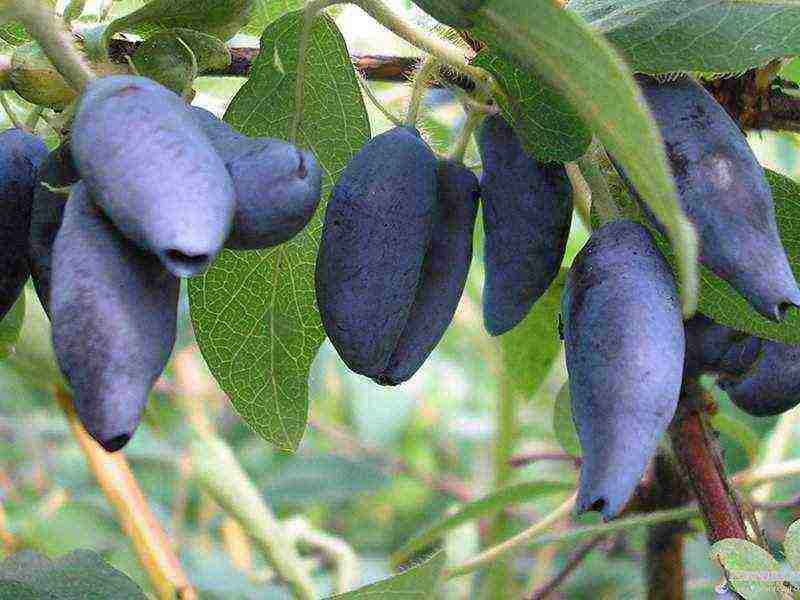
Honeysuckle of this variety is very frost-resistant, ripens early, by June 10. The bush is 1 meter high, the yield reaches 3 kg.
Berries in the form of an oblong cylinder 2.7 cm long, weighing about 2 grams. The skin of the berries is tender, violet-blue with a whitish bloom, the crumbling is average. The pulp is sweet and sour, there is no bitterness.
Pollinators - Sineglazka, Morena, Izuminka, Smolinskaya, Chernichka, Chelyabinka.
Cinderella
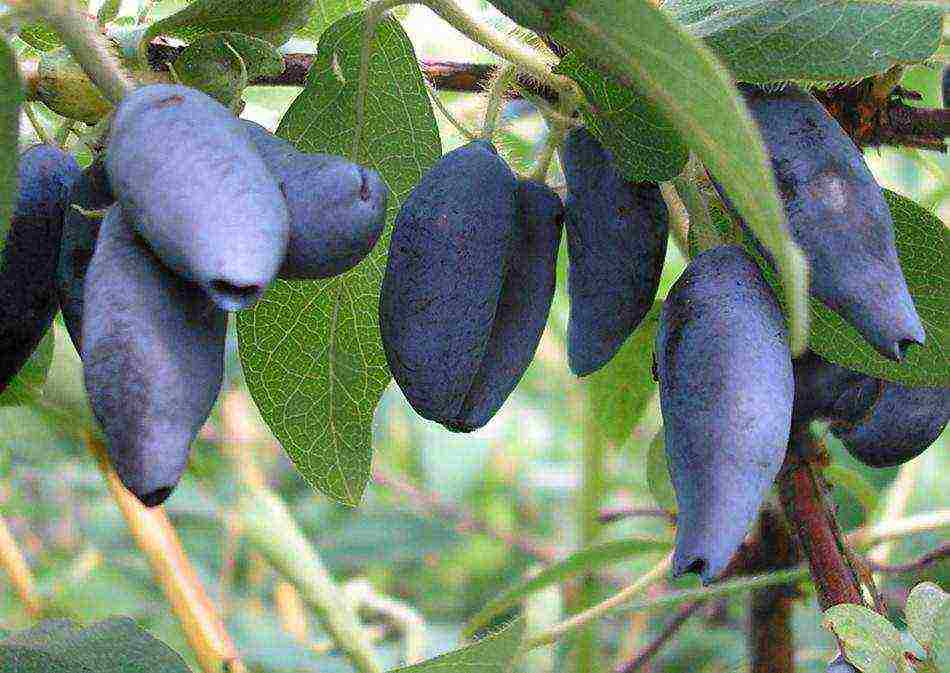
The bushes of this variety are small, up to 70 cm in height. The berries have a cylinder shape, a dark blue color with a blue bloom and a wonderful sweet and sour taste with a strawberry aroma. Fruits ripen by mid-June, berry weight up to 1.4 grams.
The yield of the bush is up to 3 kg. It is inconvenient to pick berries due to the short stature of the bush. But the plant is frost-resistant. Resistant to diseases and pests. Berries also quickly crumble. Pollinators of this variety are Lazurnaya, Gerda, Amphora, Kamchadalka, In Memory of Gidzyuk, Leningrad giant, Parabelskaya.
Leningrad giant

The bushes of this variety are distinguished by their height - 2 m. The berries are also large, up to 3 cm in length. The skin is dense, dark blue with a bluish bloom. Fruit ripening occurs unevenly throughout the month.
The pulp is sweet and sour, fibrous, ripening time is late June - early July, berry weight up to 4 grams. The yield of the bush reaches 3.3 kg. The fruits are located on the bush in large clusters, which greatly facilitates their collection. The best pollinators of this variety are Gzhelka, Blue Bird, Start, Malvina, Morena, Blue Spindle, Memory of Kuminov.
Moraine

The bush of this variety reaches a height of 1.7 m, the berries ripen by mid-June. The berries have a thin, almost transparent, blue skin with a waxy coating. The pulp has a pleasant taste, without bitterness. The fruits do not fall off the bush for a long time.
The yield reaches 2 kg per bush. The plant is frost-resistant, resistant to diseases and pests. The best pollinators of this variety are Malvina, Goluboe Vereteno, Amphora, Viola, Kamchadalka, Start, Pamyat Kuminov, Blue Bird.
Nymph

The height of the bush reaches 1.7 m. The plant is resistant to cold weather, diseases and pests. The berries are 3 cm long, curved and lumpy. The fruits ripen at the end of June.
The pulp is sweet and sour with a pleasant bitterness, the skin is bluish with a gray waxy bloom. Berry mass up to 3 gr. The yield of the bush reaches 2 kg.
The plant is hardy and rarely gets sick. The best pollinators are - Lazurnaya, Pavlovskaya, In Memory of Gidzyuk, Amphora, Chosen One.
Blue bird

The bushes of this variety are vigorous, reaching 1.8 m. The berries ripen at the end of June. The skin is blue-black with a strong bloom.
The taste of the pulp is sweet and sour, reminiscent of the taste of blueberries. The length of the fruits is average, about 2 cm, weight up to 1.2 g. The yield reaches up to 2 kg per bush.
The plant is resistant to cold weather, diseases and pests. The best pollinators for this variety are Titmouse, Start, Cinderella, Blue Spindle, Pamyat Kuminov, Malvina, Kamchadalka.
Tomichka

The height of the bush of this variety reaches 1 m, the fruits ripen in the second half of June. Berries weighing up to 2 grams.similar to a jug with an uneven surface and a purple skin with a blue bloom.
The pulp is sweet and sour, the berries tolerate transportation well. The plant is resistant to cold and disease, but sometimes it is affected by aphids.
The yield reaches 3.2 kg per bush. The best pollinators are - Pavlovskaya Goluboe Vereteno, Giant's Daughter, Blue Bird, Bakcharskaya, Vasyuganskaya. Bakchar Giant.
Honeysuckle varieties for northern regions of Russia
Due to the harsh northern climate, not all berries can be grown in Siberia. But honeysuckle is so hardy that its first berries appear at the beginning of June. Breeders have obtained special varieties of honeysuckle, suitable for planting in the northern regions.
Azure

Berry mass 1 gr. The pulp is sweet and sour with bitterness. Productivity up to 2 kg. Secondary flowering is possible, but this is bad for the yield. Fruit shedding is weak.
Fire opal
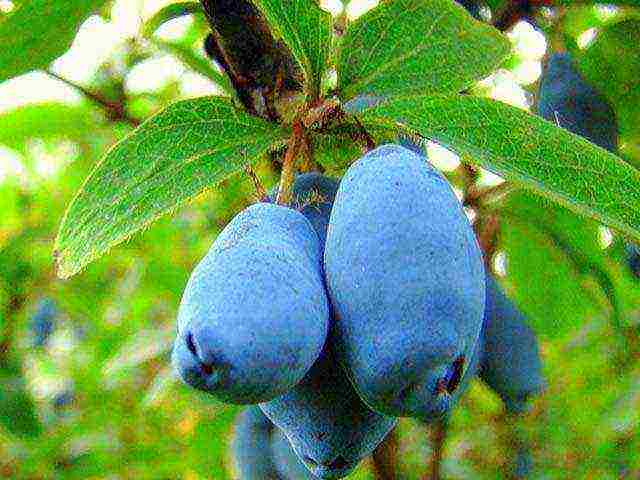
Berry mass up to 1 gr. The pulp is sweet and sour with bitterness. The yield is high - up to 4 kg per bush. Practically does not fall off. Most often, wine is made from the berries of this variety.
In memory of Gijuk
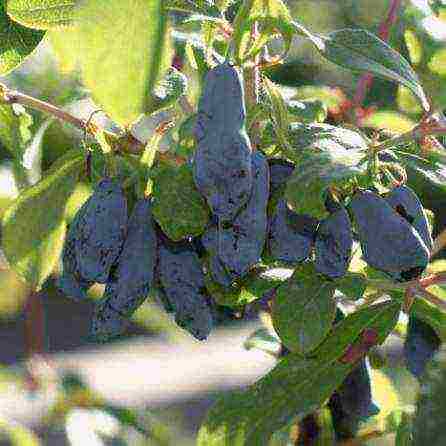
The bush is 1.8 meters high. Pear-shaped berries weighing up to 1 gr. The yield reaches 2-3 kg per bush. The berries do not crumble. The application is extensive.
Laura
Berries weighing 1.1 gr. The pulp is tender, the taste is sweet, aromatic. Friability medium Fresh application and for processing.
Volkhova
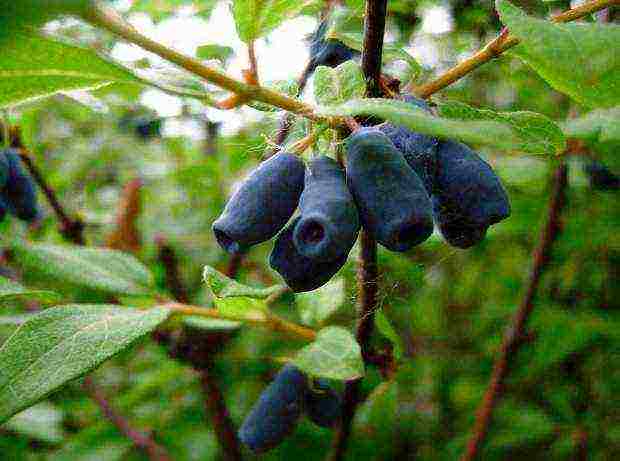
The bush is up to 2 m high. The berries are elongated with a pointed top, weighing up to 0.9 gr. The taste is sweet with a hint of strawberry. Productivity up to 2 kg per bush. Berries fall slightly. Application as a dessert.
Lenarola
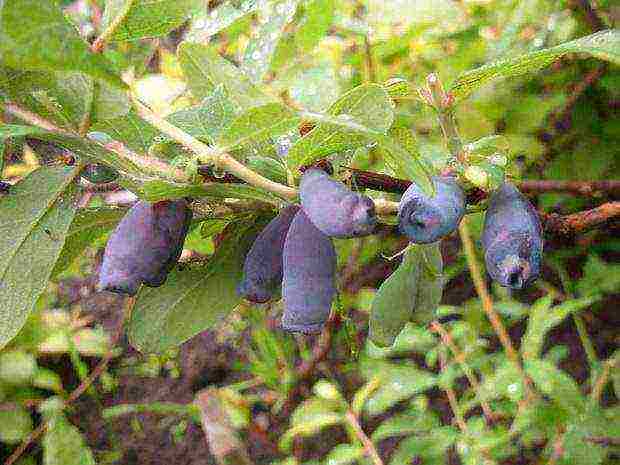
Berries weighing 1.2 grams. The taste is sweet and sour, fragrant pulp, thick skin. Decorative large flowers. Medium resistant to aphids, average crumbling. Application in desserts and fresh. Productivity up to 2 kg per bush.
Also, the above-described varieties of honeysuckle Tomichka, Cinderella and Bakcharsky Giant are suitable for planting in regions of Siberia.
The southern varieties include Dolphin, Golubinka, Rassvet, Zarnitsa. It is better not to plant them in areas of the middle lane. Because in the event of a warm autumn, they can bloom again, which will significantly reduce the yield and weaken the plant.
May honeysuckle, description of varieties
Honeysuckle Vitamin
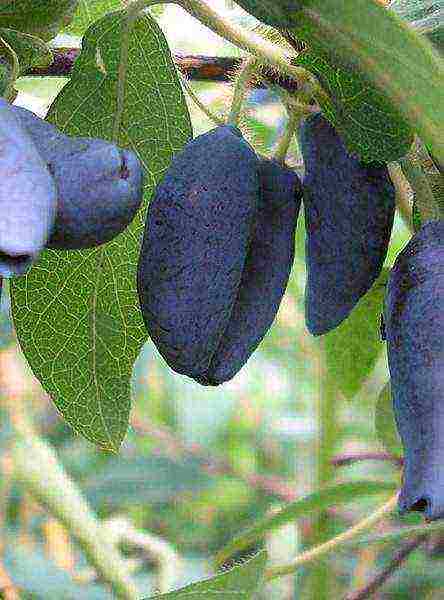
It ripens earlier than all varieties at the end of May. The bush reaches a height of 1.5 m. The berries are 1.5 cm long, sweet and sour, with a wonderful aroma, weighing about 1.8 g. The fruits do not crumble, the bush bears fruit for about 25 years.
Honeysuckle Karina
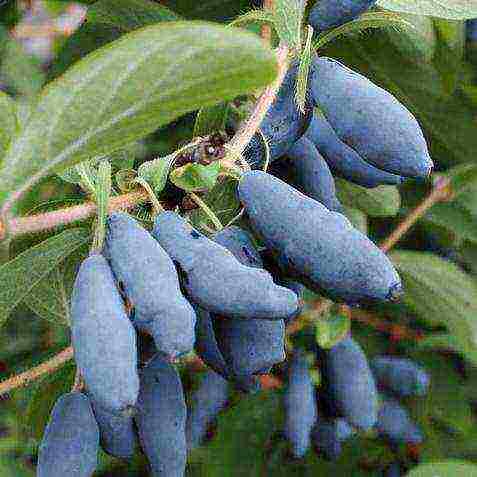
The bush is 1.5 m high, the fruits ripen at the end of May. Berries are 3 cm long, oblong, dark blue. The taste is sweet and sour. It blooms with very fragrant small flowers. The fruiting period is within a month.
Sweet honeysuckle
- Altair;
- Amphora;
- Dessert;
- Gourmet;
- Nymph;
- Pavlovskaya;
- Slav;
- Bullfinch;
- Souvenir;
Large-fruited honeysuckle
- Bazhovskaya;
- Enchantress;
- Long-fruited;
- Cinderella;
- The chosen one;
- Azure;
- Nymph;
- Moraine;
- Siberian;
High-yielding honeysuckle
- Cinderella;
- Fire Opal;
- Blue spindle;
- Long-fruited;
- Siberian;
- Moraine;
- Katyusha;
- Drops;
- Titmouse;
- Violet;
- Sirius;
Early fruit varieties of honeysuckle
- Cinderella;
- Moraine;
- Tomichka;
- Long-fruited;
- Blue Spindle;
- Viola;
- Enchantress;
- Blue bird;
- Sineglazka;
Honeysuckle varieties resistant to fruit shedding
- Fire Opal;
- Nightingale;
- Zest;
- Borel;
- Azure;
- Omega;
- Roxanne;
Why gardeners love honeysuckle
- Honeysuckle blooms early. Flowers are very beautiful in color - white, pink, yellow and lilac. Flowering continues for a month.
- Honeysuckle flowers have an incredibly pleasant scent. This attracts a lot of bees and other plant pollinators. Beekeepers often place hives next to the planting of honeysuckle.
- Honeysuckle bears fruit early. Some varieties produce berries at the end of May. At this time, the vitamin berry is extremely necessary in our diet.
- Honeysuckle berries are rich in nutrients and help to improve health in case of hypertension, vitamin deficiency, to recuperate after the flu and colds.
- The beautifully flowering and fragrant honeysuckle bushes are often planted as hedges in gardens.
The most suitable varieties of edible honeysuckle for growing
Similar articlesYes, this is important, because they pollinate each other and there will be more berries.
The benefits of garden honeysuckle
These varieties of honeysuckle are most suitable for the Moscow region, but you can plant a few more bushes, which are bred specifically for this region, give a high yield, are winter-hardy and unpretentious in care. Try other varieties: Morena, Amphora, Altair, etc. Plant, take care, and you will surely collect a magnificent harvest of berries.
Spring work on preparing honeysuckle for fruiting will require nitrogen fertilization. Usually they take 30 g of ammonium nitrate or 20 g of urea per 1 m² of soil. It is necessary to apply fertilizers before and during the blooming of the honeysuckle buds.
To obtain a high-quality bush and a high yield of honeysuckle, you will need to comply with several prerequisites.
1,5
- Bright, with a bluish bloom, tasty berries without bitterness.
- 2
- 1
- Sorceress
Vasyugan - Tomichka;
What do we associate the word "berry" with? These are round, red, yellow, less often green, taste sweet or sweet and sour small fruits. The first to come to mind are raspberries, gooseberries, and strawberries. But, even in our gardens, you can grow berries that do not correspond to this idea at all - this is honeysuckle, a berry that has an irregular elongated shape, a bright blue color and a very unusual, complex and refined taste.
Several varieties of the same type - Altai Kamchatka and I forgot they bloom at different times and if there is no pair, then empty bushes will remain
How to grow garden honeysuckle?
Bakchar honeysuckle has the most delicious varieties. The sweetest varieties: Sibiryachka (out of competition), Silginka (second place) and Roxana (third place). These varieties are generally without a hill.
- In June, 15 g of double superphosphate and 10 g of ammonium nitrate per 1 m² are again introduced. At this time, honeysuckle produces fruit buds, reduces the growth rate of new shoots.
- The most preferred planting time is autumn. Honeysuckle manages to take root well, "get used" to the place in order to winter well. Spring planting is fraught with violation of the growing season, kidney damage and weakening of the bush.
- 0,9
- Zest
1-1,3
Medium ripening, the berries are bright blue with a strong waxy bloom and a very fresh taste without bitterness.
Up to 2
Pavlovskaya - Tomichka;
The best varieties of edible honeysuckle of domestic selection
Many gardeners are interested in what varieties of edible honeysuckle are most suitable for growing in our conditions. Below we will provide descriptions of the most interesting varieties of domestic and foreign selection that can be bought in garden centers and nurseries, as well as what kind of care they need to provide in the garden.
It is very important - self-infertile. 3 bushes of different varieties will give sufficient pollination - always wake up with the harvest. There are a lot of varieties now, and even if you choose one with a bitterness, do not be discouraged, they make the most delicious jam and compote: the bitterness goes away during heat treatment, and the taste is brighter.
| A very good variety, in terms of taste, from the already relatively old varieties - Morena. | You are determined to grow honeysuckle on your site, varieties for the Moscow region have undergone special selection and adaptation. Since 1950, purposeful work has been carried out in the Moscow Botanical Garden to develop a honeysuckle variety without bitterness in berries. Samples for this were brought from the Urals, the Far East and Siberia. Breeders A.K. Skvortsov and A.G. Kuklina managed to develop a new variety of titmouse honeysuckle. Its distinctive feature is stability and early ripening of berries. | | Bright blue, thin-skinned berries, the sweetest of all, no bitterness, late ripening. |
| 1,2-1,5 | Berries are sweet and sour, without bitterness, early. | Long-fruited | 1,2-1,3 |
| Blue Spindle - Blue Bird; | The first mentions of an unusual shrub with delicious blue berries were voiced by the Russian explorer Atlasov after his trip to Kamchatka at the end of the 17th century. Then it turned out that this berry is widespread and enjoys great love among the inhabitants of Altai, Sayan Mountains, Transbaikalia, Primorsky Territory. In those regions, honeysuckle is considered not only an excellent delicacy, but also a very effective healing agent. | Neighborhood. alas, it has no options | The blue spindle, which everyone advises, is not the best variety for my taste, I would not plant now. Compared to the above, it loses much in the taste of berries. Another drawback of the blue spindle variety is that it crumbles very much, if the berries are not picked in time, most of the harvest will end up on the ground. This is a very old variety of the Barnaul selection, in the state register since 1989, now there are much better varieties. |
| This is a vigorous shrub with a round crown, capable of growing under favorable conditions up to 2 m. The places are chosen for planting sunny, but this variety tolerates temporary shading well. The plant should be provided with regular watering, especially during the period of ovary of fruit buds. Berries with a strong aroma, completely devoid of bitterness, the taste is sweet and sour. The shape of the fruit is elongated, slightly oval. The length rarely exceeds 3 cm. The top of the berry resembles a saucer. The skin of the fruit is thin and tender. The titmouse honeysuckle variety has weak crumbling. | How to plant honeysuckle: | Chelyabinka | 1,5 |
| Bazhovskaya | 2 | Compact bush, early harvest, dessert taste. No bitterness. | Chelyabinka - Long-fruited. |
| The fruits of honeysuckle (only edible!) Are used for hypertension and cardiovascular diseases, internal bleeding. They have the ability to strengthen the walls of blood vessels, cleanse the gallbladder from sand and stones, and are also useful for gastrointestinal disorders and poisoning. Fresh berries, pounded with sugar and in the form of jam, act as an antipyretic agent. | . | Honeysuckle of any variety will be much sweeter, tastier, larger and without bitterness if watered abundantly during the period from buds to pouring berries. And during the ripening period, you no longer need to water unless absolutely necessary. | Honeysuckle Titmouse has one peculiarity. Do not be alarmed if a bark detachment occurs in a plant three years old. It slides down with a tape, exposing brown wood. |
| Saplings 2-3 years old are most preferred. They are quite strong and have a well-branched root. | 2 | Delicious, aromatic, berries without bitterness, do not crumble. | 2 |
| 1,5 | Viola | The ideal place for planting bushes is an open, sunny place, and the soil must be improved to a high level of fertility and moisture capacity. The easiest way to do this is by adding peat, leaf humus in large quantities to the planting pit. The bottom of the pit can be covered by 20-30 cm with dry grass and garden waste. | |
| The composition of edible honeysuckle berries is truly unique - it is a storehouse of the most important biologically active substances and vitamins. In particular, these berries are considered champions in terms of the content of P-active substances and vitamin C in an ideal ratio for the human body. Berries are an excellent antioxidant. | The most delicious and sweet varieties: Sibiryachka (the sweetest honeysuckle), Silginka (sweet with sourness), Roxana (sweet-sour taste, not sweet-sour, but sweet-sour, since it is more sweet). These varieties have practically no bitterness. | Honeysuckle can be cut with last year's and green cuttings, but it is best to cut it with green cuttings in the phase from the end of flowering to the ripening of the first berries. Then the rooting rate of cuttings is 80-90%.Cut into three buds, cut off the bottom 2 pairs of leaves, dip in korevin and plant in the ground somewhere in partial shade, cover with a piece of plastic bottle on top. Rooting begins to take place in 14 days. By autumn, it finally takes root and can be transplanted to a permanent place. However, it is better not to do this and wait with the transplant until next autumn, and also cover it for the winter, since it can freeze out in the first winter. | A new mid-early variety, which is recognized as the best for growing in the Moscow region. Honeysuckle variety Nymph has a low bush, with a rounded and lush crown. Branches are straight, brown. The berries are bluish-blue in color, with a thin waxy coating. The shape of the fruit is elongated, a bit like a spindle. The berry is rather large, weighing up to 1.16 g. The taste is pleasant, sweet with a strong aroma. |
| The distance between the bushes of honeysuckle is maintained when planting about 1.5 m. | 1.1 | Blueberry | 1,5-2 |
| The berries are long, bumpy, with an excellent taste. Ripening very early. | Up to 1.5 | Pits should be made at a distance of 1.5 meters from each other - this way you will provide ideal conditions for cross-pollination. After planting, you need to pour at least 1 bucket of water under each bush. | But, it would be wrong to say that the benefits are the main reason to rank this unique berry among the top 10. Edible honeysuckle also has a number of other great qualities: |
| Of the other varieties, I like Morena. Although now there are a lot of varieties and I don't know about everything. | So I don't know what kind of honeysuckle I have, but it is sweet, blue and long in color when it ripens. Also dug up from a neighbor. But about Timiryazevka. A neighbor bought an apple tree there before budding, but it turned out to be a pear. I think it is better to “uncover” all the same, as experience shows it is always more reliable. | For a yield of the Sinichka variety, it is better to plant the Amphora variety honeysuckle nearby | Planting of 3-4 varieties will be required to ensure pollination. |
| Very good taste and berries do not crumble for a long time. Ripening - early August. | 2,5 | One of the best large-fruited varieties of medium ripening, dessert berries. | Swallow |
| 1 | Plants of edible honeysuckle do not need to be pruned, as is customary with all shrubs, since pruning in honeysuckle delays growth and the beginning of fruiting. | Refined taste: sweet and sour, in some varieties - with a piquant bitterness, others without bitterness, high juiciness. | You need to plant at least two, and preferably three varieties. Honeysuckle is self-fertile and needs to have a pollinator. The taste and size of the berries of any variety of honeysuckle becomes much better if it is well watered during the flowering process, setting the fruit and pouring the berries. Then even the varieties with bitterness are quite tasty. I have 4 grades. This berry is the very first and very tasty! also very useful! |
| That's right, I have 3 different varieties nearby ... They have different ripening periods, consistent - first sweet, then sour, then bitter ... With a difference of about 2 weeks ... comfortable.. . and also - if you plant only one variety - there will be no berries. But what they are called - I don’t know, I’ve forgotten. | Fruiting up to 25 years in Nymph honeysuckle, the description of the variety contains data on high resistance to frost and pests. | Examine the bush carefully. You must cut out damaged and broken branches and remove dry roots. Then you need to immerse the lower part of the honeysuckle in the earthen mash. | Foreign varieties of edible honeysuckle available to gardeners in our country are real masterpieces of selection. Among them, it should be noted such as George Bugnet, Marie Bugnet (Canada) - these are truly unique hybrids: the berries ripen not simultaneously, but from June to August and do not crumble for several weeks. The German variety Amur and Blue-Gray (USA) is distinguished by long berries with a great taste, absolutely no bitterness. |
| Up to 1 | Lapis lazuli | Up to 1.5 | The most resistant variety to diseases and pests. Frost resistance up to - 48 C. Berries are sweet and sour, with bitterness. |
| Adult plants do not require annual pruning. It's just that every spring you need to remove dry, broken or interfering with harvesting branches growing inside the crown. For the rest, the conditions for growing this crop and caring for it are the same as those of black currant. | This is the earliest berry. In central Russia, it ripens in early June, in the southern regions - in mid-May, and in the north - in the second part of June. Today there are also late-ripening varieties, so fruiting can be extended almost until August. Care consists only in the timely collection of the crop. | Plant! You will not regret it! | |
All known varieties of honeysuckle are self-infertile, that is, fruit ovaries are not formed without cross-pollination. For a harvest, you must plant at least 3 different plant varieties on your site.
Honeysuckle varieties for the Moscow region
They lower the bush into the hole and straighten the roots, at the same time monitor the location of the root collar. It should be at ground level or 2 cm lower.
Honeysuckle is an adornment for any garden. Its flowers have an intoxicating aroma, and the berries have an unusual taste. The popularity of the plant grows every year and more and more often low bushes with small bluish-blue fruits appear in the gardens of the Moscow region. Honeysuckle is appreciated for its easy care, the ability to easily endure harsh winters and produce a stable harvest. The shrub is very hardy and resistant to recurrent frost during flowering. At a temperature of -5 ° C, the inflorescences remain on the bush and bear fruit well. This bush is a record holder! Just imagine that a plant is capable of bearing fruit up to a "respectable" age. Small berries can be plucked from a bush that has long been over 30 years old. Impressive?
How to choose a place, prepare the soil for planting
Flat fruits of excellent dessert taste, ripening in early July.
Up to 2.5
1-1,2
My joy
Planting honeysuckle
Officially in Russia, honeysuckle was added to the list of berry crops, oddly enough, only in 1956, and abroad even later. But during this time, more than a hundred large-fruited and high-yielding varieties have appeared, the planting of which will be appropriate in gardens and dachas. Interestingly, most of the names are associated with the color of the fruit: Dove, Azure, Blue Spindle, Blue Bird, Titmouse, etc.
The fruits can be consumed not only fresh - they are perfectly stored frozen, they can be dried, used for making compotes, juice, preserves, marmalades and jam. Wine of excellent taste is even made from these berries.
I have 5 honeysuckle bushes, I know for sure that there is a Blue Spindle - a good variety, Titmouse - serves more as a pollinator, but the berries are also tasty, they just are smaller, I don't remember the other varieties, tags in the country. But I don't have absolutely sour ones, all are sweetish. I really appreciate this beautiful berry.
-
- The root is buried in the ground and watered at the rate of 10 liters of water per one honeysuckle bush.
- There are known cases of fruiting of honeysuckle at the age of 150 years.
- Sinilga
- 2-2,2
- Very tasty berries, ripen early.
- 1,5-2
Proper care of the bush
Today, for amateur cultivation from Russian varieties of edible honeysuckle, the following can be called:
Edible honeysuckle is an unpretentious and durable plant. Lives and actively bears fruit up to 60-80 years. The shrub is very frost-resistant - it is not damaged even at temperatures down to -45 C.
Honeysuckle is a cross-pollinated plant and is not pollinated by its own pollen — it is self-fertile. You need at least two varieties. For a long time I had only two varieties — they were well pollinated. Yes, I agree — the most delicious Bakchar varieties — they are the latest achievements in breeding, large-fruited and very productive.
Chrenki is reliable But you need to plant at least three varieties, otherwise there will be no berries If you buy that sweet variety GOBE spindle
The bush is low, the crown is dense, squat. The fruits are sweet, fragrant, rather large. The berry mass reaches 1.1 g, the length is 2 cm.The shape of the fruit is oval, slightly elongated and pointed towards the apex. The skin of the berry is thin, the color is blue with a bloom. Honeysuckle Chosen is a late-ripening variety. The yield is high. Up to 3 kg of berries are harvested from one bush. The Chosen one is characterized by the union of berries in pairs. It keeps well on the bush, does not crumble for a long time.
Honeysuckle varieties
The surface layer around the bush is sprinkled with mulch (peat, humus).
Titmouse variety
It is preferable to plant the plant in a bright, well-warmed place by the sun. Although, according to some gardeners, it develops well and weakly shaded places, for example, among tall fruit trees. Loamy, sandy loam soil is suitable. The main requirement is that there is no excess moisture or, conversely, too dry soil. Honeysuckle will develop poorly on acidic soils, poorly drained and heavy in texture. The close occurrence of groundwater (less than 1 m) is also highly undesirable. Pay attention to the openness of the site and the effect of the wind on it. In honeysuckle bushes, young leaves suffer from it, developing and already ripe fruits come off.
2
Variety Nymph
Very large tasty berry, ripening - July
Pushkinskaya
1,2
Variety name Fruiting of bushes begins at the age of three, care is simple, and the average yield is 1-3 kg per bush. Although some varieties, for example, Amur of German selection, under good conditions, gives up to 5 kg of rather large berries without bitterness.
Chosen variety
Honeysuckle needs to have several varieties bred on the same basis - for example, Kamchatka honeysuckle. she herself is not pollinated because the stamen and pistil mature in the flower at different times. therefore, a second and third grade is needed in which they also ripen at other times. cross-pollination occurs - honeysuckle Blue spindle Commonwealth. Pushkinskaya. Malvina
Nymph, Amphora.
Honeysuckle Variety Chosen One is good for making desserts, homemade preparations and making wine.
Growing honeysuckle can be a pleasure. This is a "grateful" plant that always bears fruit and is rarely exposed to disease. You need to monitor the oxygen enrichment of the root system. For this, surface loosening is carried out, no deeper than 10 cm, otherwise you risk damaging the root system. Remove weeds and sprinkle mulch over the bush area to provide sufficient moisture to the roots close to the surface. The minimum layer of humus, peat or other existing organic matter is 4 cm. When using sawdust, it is necessary to apply nitrogen fertilizers (40 g per 1 m²). During the season, loosening and weeding is carried out 2 times. With the onset of autumn, the bite zone is carefully dug in. The soil must be prepared carefully. All weeds are removed, especially perennials. They can greatly weaken the planted honeysuckle. Fertilize the site by introducing organic matter. In the fall, 10 kg of manure, humus or prepared compost are dug up together with the soil. On 1 m² of land add 30 g of double superphosphate and potassium sulfate. For liming, you need from 200 to 400 g of lime for each m².
About 1
Edible honeysuckle in Russia - video
Which is the sweetest honeysuckle? a neighbor has three bushes. sour, sweet and sour and sweet. sorts of it,
Sentient Dolphin
Malvina
1
Late grade, berries with bitterness, excellent grade for preparing blanks.
Yield per bush (kg)
The only drawback of this type of berries is that they ripen almost at the same time and immediately crumble. And their skin is very delicate and bursts even from the touch of a hand, therefore, when it hits the ground, most of the berries are damaged. For this reason, edible honeysuckle berries are not grown commercially, and breeders are not very fond of it. Almost all known varieties were bred by IV Michurin, who generally considered honeysuckle to be berry No. 1, or by amateur enthusiasts.
Natalya Thank you
Delicious variety Blue spindle Really needs several varieties for cross-pollination
coliri
In general, local gardeners have already noticed that the more you water the honeysuckle, the sweeter it is. Independent of the variety.
pevaly
You do not need to select varieties of honeysuckle for yourself with a photo, you should read the available information on the network or ask the garden center what will grow better in the Moscow Region.
Dina
If you want to get a high yield, take care of soil fertility. A well-prepared planting site will provide honeysuckle with useful substances for 2 years.
Olga
When planting in spring or summer, lack of organic matter, it is permissible to apply them directly to the pit or prepared trench. The dimensions of the depression for one honeysuckle bush are made about 60 cm wide, and the depth will be 50 cm. When planting in trenches, they are dug out of the same width and depth as the hole. Organic and mineral substances are introduced in the same proportions as when digging the earth in the fall (calculation for 1 hole or running meter of a trench).
Prokhor Kupriyanov
Late ripening, berries with a slight bitterness.
Natalia Solovieva
1,5
The fruits are early, cylindrical, sweet and sour, with a very pleasant aroma. Very frost-resistant variety.
which variety of honeysuckle produces the most delicious fruits?
Unknown Unknown
Altair
Weight of the 1st berry in grams
Tatyana Ivanova
By the way, in order to keep the berries intact during ripening, it is recommended to hang a thin net under the bush (you can use gauze) and lightly shake off the branches from time to time - ripe berries crumble. Or you need to collect them by hand and put them in a container, only 2-3 layers maximum.
Polina shubina
I have 5 bushes, plant this berry be sure. It's a pity I don't remember exactly my varieties, records at the dacha)) But they are really all different in taste and in the shape of the berries.
Alexey Losev
It is better to buy seedlings in nurseries or specials. stores. At least 3 bushes.
Sentient Dolphin
The bitterness of honeysuckle disappears in the jam
For 3 years, 10 kg of rotted manure or compost is brought under the bush during autumn digging. The introduction of organic matter will have to be done every third year of the plant's life. Mineral additives are added annually. In autumn, add 20 g of double superphosphate and potassium salt to each bush of honeysuckle or 1 m² of soil.
It is better to choose the time for planting in early autumn (September). If it is planted in spring, then this must be done before the first buds on the bush begin to open. Transplant in the summer should only be after the end of growth.
Slavyanka
1
Sineglazka
Irina Shabalina
About 1
Tina Ezdakova
Description of berries and taste, other characteristics
Olga
It is best to plant bushes in the second half of August or early autumn. Spring planting delays the onset of fruiting by another year, no matter what kind of care. Several specimens should be planted at the same time and preferably of different varieties. This is because this plant is cross-pollinated. If you plant only 1 bush, then the harvest can not wait. The best inter-pollinators are such pairs of domestic varieties:
Dina
I planted six different bushes - I think they will give berries for 3 years, but since it did not grow almost, I cut it off a little in the fall. Hope for a harvest. They say its roots develop for 3 years, then the bush grows and berries.
Just Pooh
Blue spindle
.

